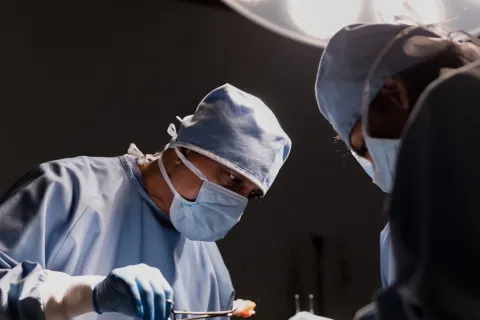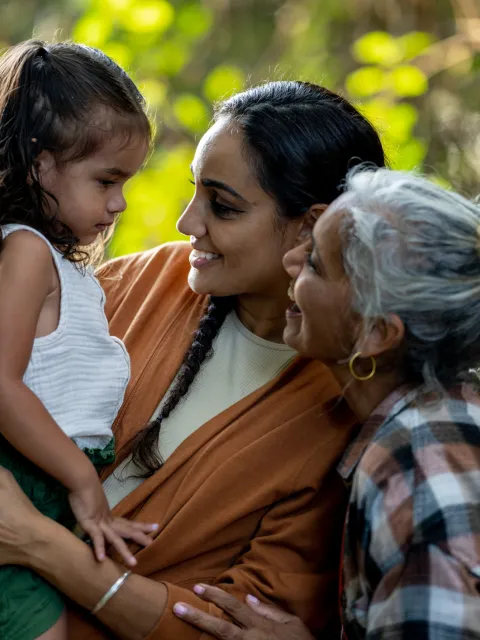How integrated comprehensive cancer care can help drive UHC
UICC members in Indonesia and Thailand talk about how cancer control and care is integrated in their national healthcare systems.

Universal Health Coverage (UHC) is a key focus area for UICC’s work in cancer control, as it holds the potential to ensure that everyone is able to access effective and affordable cancer services at the highest standard possible.
Comprehensive cancer care requires strong and well-integrated health systems to detect and diagnose cancers and refer patients to centres where they can access treatment and supportive care. Many of these systems are critical to care for patients with other diseases, which provides opportunities to integrate cancer at all levels of the health system as part of the drive to UHC.
The National Cancer Institute in Thailand and the Faculty of Medicine, Universitas Indonesia are among UICC members who have contributed to and continue to play a role in expanding UHC and integrating cancer care in their countries. Indonesia and Thailand can serve as case studies in how quality cancer care can be made more widely available in coordination with a UHC benefit package and strategy and how regional differences can be addressed. They also highlight gaps that exist in cancer care coverage within a national health insurance scheme, why these gaps exist, and how cancer organisations are advocating to see them filled.
A decentralised health system in Indonesia caters to regional disparities
The primary care infrastructure in Indonesia was virtually non-existent in 1960, but has grown to encompass over 20,000 health care centres by 2001. While a number of indicators such as life expectancy and infant mortality improved dramatically over this time, gaps remain and gains have been uneven. The one-size-fits-all approach of a heavily centralised governance structure proved inadequate to address the needs of the different populations across Indonesia in terms of socioeconomic level, lifestyle, geography, cultural context and beliefs. [1]
Indonesia implemented a decentralised system of government in 2001 and a new national health scheme was introduced in 2014, with the objective of enabling districts to better respond to the gaps in health services and develop different models of health coverage according to local disease burdens and other requirements. The national health scheme now covers almost 80% of the country’s population, with the other 20% largely covered under private insurance. This has contributed to improving health equity and access to care services.
With regard to cancer care, the national health insurance scheme aims to provide diagnosis and treatment for all cancer types. This package includes financial protection to access chemotherapy, radiotherapy and surgery with a cancer diagnosis in district and national facilities.
Cancer prevention and screening remain important gaps that are not covered. “We only screen when a patient presents with symptoms,” says Prof. Syam, Dean of the Faculty of Medicine, Universitas Indonesia. This is problematic, as the later a cancer is detected, the harder it may be to treat and the poorer the outcome may be.
“People should be screening for certain cancers at certain ages, for instance at 50 for colorectal cancer, even without symptoms. But we only do diagnosis for symptoms. This is done by a general practitioner, who then refers the patient to a specialist.”
– Prof. Ari Syam, MD, Dean of the Faculty of Medicine, Universitas Indonesia, Internal Medicine, Gastroenterologist
If all patients are symptomatic, by the time they've been diagnosed and made their way through all the referrals, the window of opportunity for curative treatment is substantially reduced and increase. Late diagnosis can also extend the duration and extent of treatments, as well as their side effects and costs.
A notable exception has been the implementation in 2014 of a national cervical cancer screening programme thanks to the efforts and recommendations of the Faculty of Medicine, Universitas Indonesia working with the Society of Oncology. Cervical cancer is the second-leading cause of cancer in Indonesia after breast cancer and one that is particularly preventable through vaccination and early detection. It is also a cause supported by the First Lady of Indonesia, Iriana Jokowi.
In practice, the screening and testing for human papillomavirus (HPV), which causes a large majority of cervical cancers, are conducted at community health centres and largely concentrated in provinces where the incidence of cervical cancer is high, says Prof. Syam, Dean of the Faculty of Medicine, Universitas Indonesia. These and other prevention programmes are often funded through private sector grants or donations, for instance from the national oil company, or may depend on the will of provincial authorities and political support to keep them running long-term.
In part for these reasons, the cervical cancer screening programme was only available in 8 of 34 provinces as of 2018, and there remained socioeconomic disparities in access and lack of awareness and participation, with only 7.3% of the target population of women aged 30-50 covered almost five years after the programme was launched.[2]
Prof. Ari Syam says that the situation is similar with regard to HPV vaccination, where local funding and efforts often determine whether a vaccination programme exists or not. He says, however, that there are concerted efforts to have the government extend HPV vaccination services nationwide and have the national insurance programme cover them.
To support advocacy for more cancer prevention measures, including early detection and raising awareness, Prof. Syam agrees that there is a need for more health economics studies to emphasise the cost-effectiveness of prevention measures. While the national and local governments understand the health benefits of expanding services and coverage for prevention, he says they may not be fully aware of the financial benefits and so may not be willing to allocate scarce resources to prevention and early diagnosis programmes.
To address this, Prof. Syam emphasises the need for research and specialised knowledge in oncology for early detection, as well as greater human resources and funding. He also highlighted the importance of a more coherent national data registry for cancer, to help track the impact of different interventions on the total burden, stage and survival of cancer patients across Indonesia’s different regions.
Collaborative efforts in Thailand to cover the full spectrum of cancer care
Since 2002, everyone in Thailand has access to health coverage, through Universal Health-care Coverage Scheme (UCS) that covers 75% of the population, a Civil Servant Medical Benefit Scheme (7%) and a social security scheme for private sector employees (covering around 17% of the population).
The goal of Thailand’s healthcare reforms was to expand and improve health services as well as lower financial risks and catastrophic spending. In both regards, UHC in Thailand has met with success, by markedly reducing health impoverishment and increased access to quality care through a network of regional, general and community hospitals.
Cancer surpassed infectious diseases and other non-communicable diseases to become the leading cause of death in Thailand in 2000. To drive coordinated action nationally, the first national cancer control plan was launched in 1997 and covered the full spectrum of care as well as measures to strengthen the national cancer registry, building on a system that had been established as early as 1967.
The national plan was designed to integrate six areas of cancer control into the health care system: cancer informatics, primary prevention, early detection, treatment, palliative care and cancer control research.[3] Building on this Thailand’s UHC, through the three different insurance mechanisms, provides access to and coverage for cancer screening and early detection, treatment and palliative and supportive care.
Dr Suleeporn Sangrajrang, Deputy Director of Health System Development at the National Cancer Institute (NCI), says that the Ministry of Health established 13 regional health departments, with the objective of separating and building capacity for treatment to address the centralisation of care solely in Bangkok. The Ministry of Health operates seven cancer facilities, which provide a range of prevention, screening and treatment services, and 106 community hospitals each with some capacity for treatment, notably chemotherapy, and the provision of medicines and training for nurses.
“The health insurance system in Thailand pays for all cancer care. Those with government insurance can go to any hospital, while those covered by the UCS and social security schemes first consult at primary care facilities and, if diagnosed, they are referred to an oncologist and regional cancer centre for treatment.”
– Dr Suleeporn Sangrajrang, Deputy Director of Health System Development at the National Cancer Institute
Dr Sangrajrang explains that NCI’s advisory role with the government focuses primarily on how to invest most effectively in cancer services to address patient needs through health technology assessments. The NCI also promotes investing in the education of primary care physicians to identify early cancer symptoms, as well as nurses in screening protocols at community hospitals.
A particular emphasis has been placed on screening for breast, cervical and colorectal cancers. Breast cancer has passed cervical cancer as the most commonly diagnosed women’s cancer in the country and, Dr Sangrajrang explains, these are also the three types of cancers that WHO recommends focusing on as they are amenable to screening and can considerably increase chances of survival. Looking ahead, Dr Sangrajrang sees potential in the use of artificial intelligence to help better identify cancers at an earlier stage but the expertise for such technology has not yet been developed in Thailand.
To further strengthen the integration of cancer care into the national health system and see better outcomes, Dr Sangrajrang says there is a need to focus on prevention, improve the awareness and knowledge about cancer among the general population, and fight misinformation. This means providing reliable data on risk factors to encourage behavioural changes, explain more efficiently the need for and benefits of screening, and improve the system for self-testing and collecting samples for diagnosis. “Everyone should screen for breast, cervical and colorectal cancer at least once in their lifetime,” she says.
Advancing the cause of UHC in Asia
The University of Tokyo published in the May edition of the Japanese Journal of Clinical Oncology a collection of articles based on the lecture series “Is UHC for cancer in Asia an achievable goal?” (Guest Editors: Hideyuki Akaza and Norie Kawahara).
In his Forward, Dr Tetsuo Noda, Chairman of the Japan National Committee for UICC and Director of the Cancer Institute at the Japanese Foundation for Cancer Research, writes:
“In order to raise the level of cancer treatment in Asia, we must not only concentrate on the medical characteristics of the disease, but also adopt a more macro perspective that takes into account the social determinants of cancer in Asia, including social structures, culture and economy.”
Dr Noda further writes that UHC for cancer is an urgent issue, with many Asian countries facing the challenge of ageing populations. These lectures highlight the fact that to achieve UHC for cancer, human resources from a wide range of fields – governments, medical institutions and private sector stakeholders – must combine efforts and find solutions to multiple issues from prevention to treatment.
Advancing the cause of UHC in Asia
The University of Tokyo published in the May edition of the Japanese Journal of Clinical Oncology a collection of articles based on the lecture series “Is UHC for cancer in Asia an achievable goal?” (Guest Editors: Hideyuki Akaza and Norie Kawahara).
In his Forward, Dr Tetsuo Noda, Chairman of the Japan National Committee for UICC and Director of the Cancer Institute at the Japanese Foundation for Cancer Research, writes:
“In order to raise the level of cancer treatment in Asia, we must not only concentrate on the medical characteristics of the disease, but also adopt a more macro perspective that takes into account the social determinants of cancer in Asia, including social structures, culture and economy.”
Dr Noda further writes that UHC for cancer is an urgent issue, with many Asian countries facing the challenge of ageing populations. These lectures highlight the fact that to achieve UHC for cancer, human resources from a wide range of fields – governments, medical institutions and private sector stakeholders – must combine efforts and find solutions to multiple issues from prevention to treatment.
Last update
Friday 28 May 2021
